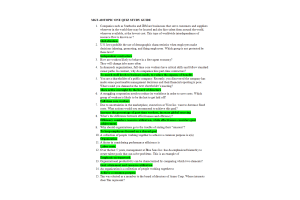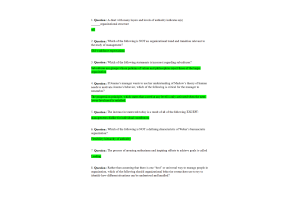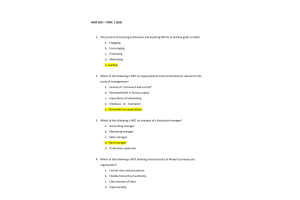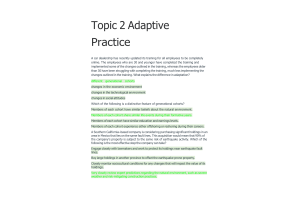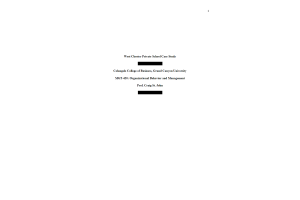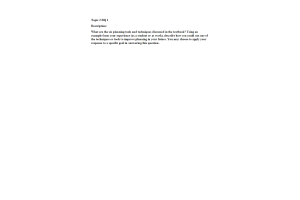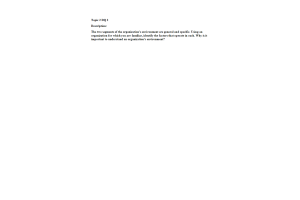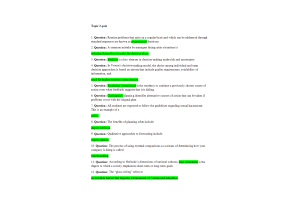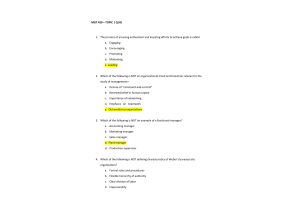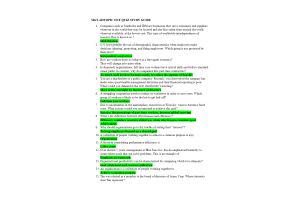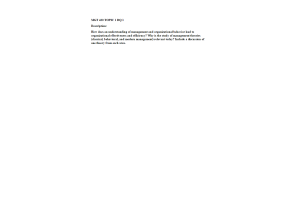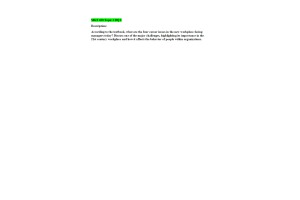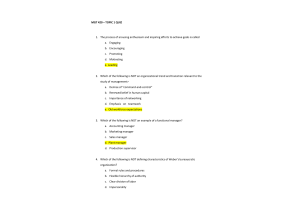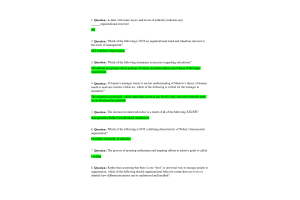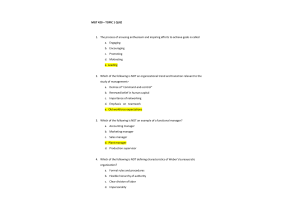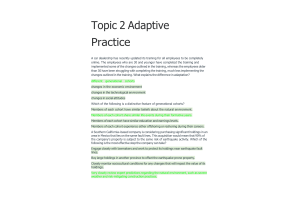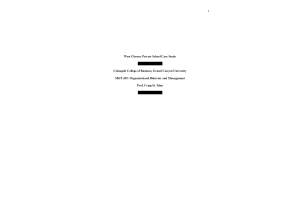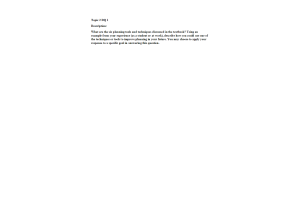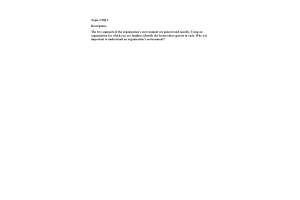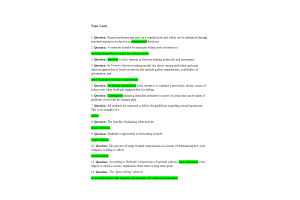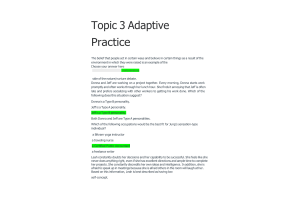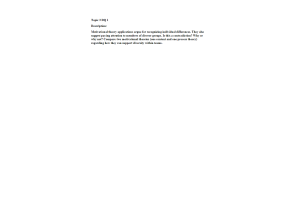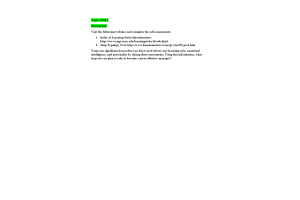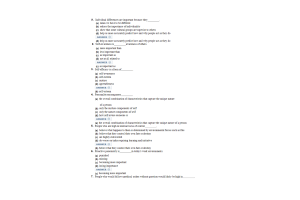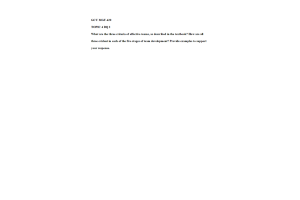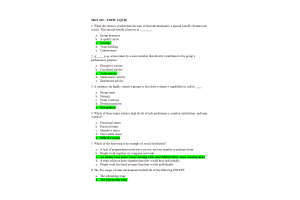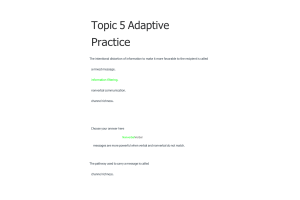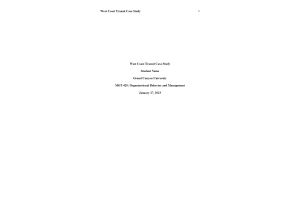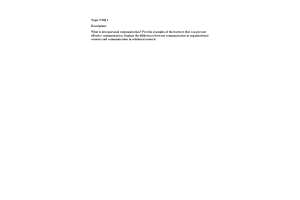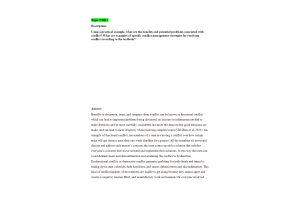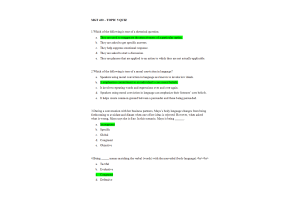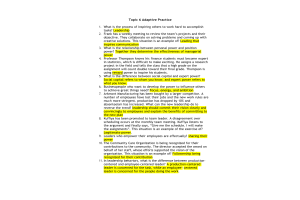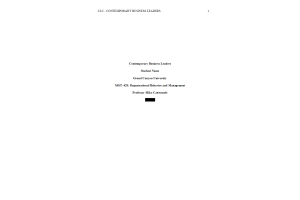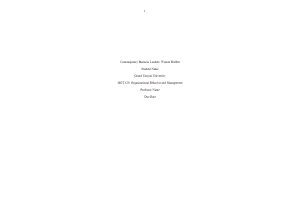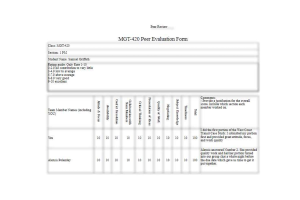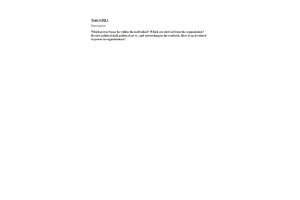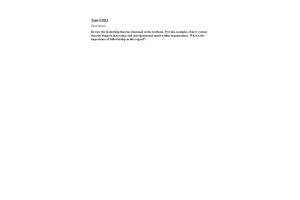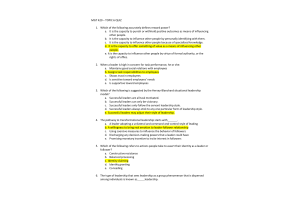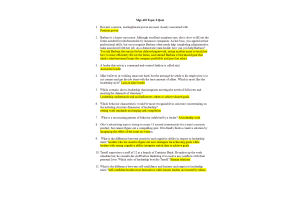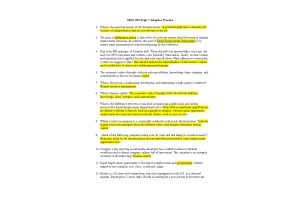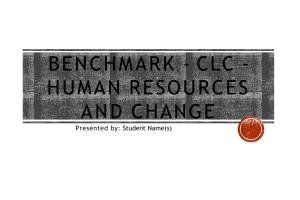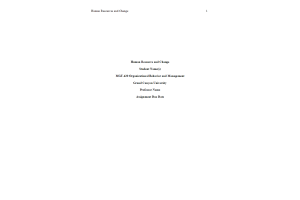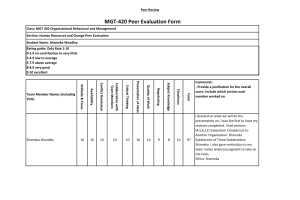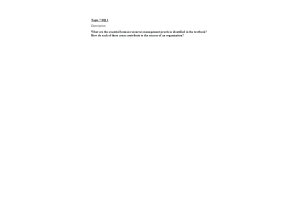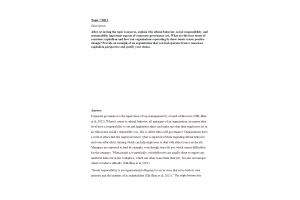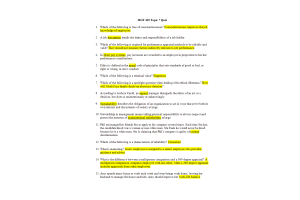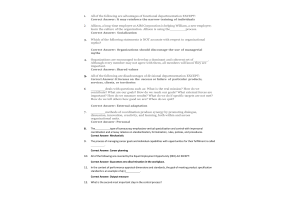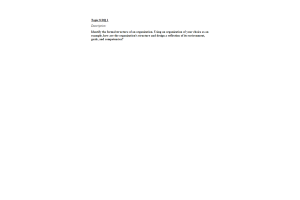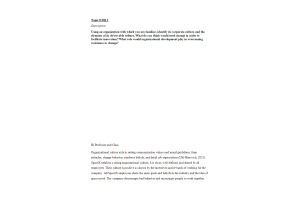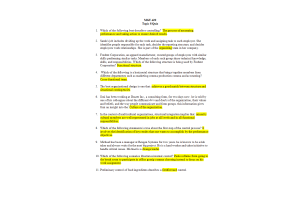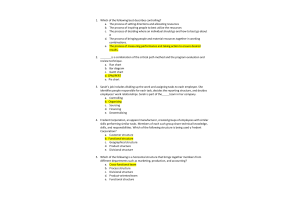MGT 420 Topic 3 Quiz Practice
- $35.00
- Marcia arrives at her first job after graduating with a master’s degree. She is not very enthusiastic about the job and produces marginal work. Because the team thinks Marcia is a really good person, they are willing to fix Marcia’s mistakes.
- After her first month on the job, Marcia’s supervisor realizes what is happening and tells the team they are not helping Marcia by covering up her mistakes. The supervisor orders them to allow Marcia to succeed or fail on her own. Once Marcia is forced to rely on herself, she realizes that she needs to improve her attitude and work performance. What type of behavior does this describe?
- A theory that states that behavior that results in a pleasant outcome is likely to be repeated, whereas behavior that results in an unpleasant condition is not likely to be repeated is known as the law of
- A technique that is designed to encourage positive behavior by withdrawing negative consequences to reduce the likelihood of an undesirable behavior being repeated is known as
- A supervisor always provides public positive feedback, which often includes a tangible gift (gift certificates, tickets to local events, and other coveted rewards) when a team completes a project within the stated budget and allotted time, and with a product that satisfies the customer. This supervisor believes that these rewards will increase the likelihood of desirable behavior in the future.
- This approach is known as
- Galen started a new job by showing up fifteen minutes before the official start time, taking a short lunch, and leaving approximately fifteen minutes after the official quitting time. During the first week Galen's supervisor takes him aside and tells him that he is really impressed with the fact that Galen is so punctual and dedicated to the work. The next week Galen’s supervisor once again compliments Galen on his punctuality and hard work. Galen continues this
- behavior while he works under this supervisor. What type of conditioning has occurred here?
- A supervisor is reviewing the past year’s performance and notes that his team accomplished a lot. He believes that the successes are due to his leadership. However, there were some failures and he places the blame for those failures on several team members. What type of perception does this describe?
- One of the ways to build or enhance self-efficacy is to
- A supervisor in an aging production facility observes that the facility is poorly lit, does not have a good temperature regulator, is often too hot or too cold, and has some outdated equipment. The supervisor also notes that quite of few of the workers in the production facility are not as productive as the workers of twenty-five years ago. The supervisor has a chat with one of the vice presidents to describe the situation, and relates to the vice president that the workers of today just do not have the strength of character that previous generations did.
This is an example of
- One way that people make sense of the world is to understand why something happened to them personally. This is known as attribution. For example, suppose a student gets a poor grade in a class. The student responds by saying “the teacher doesn't like me,” as the cause of the bad grade. The average grade in the class was 95. What element of attribution is affecting the student’s perceptions about the course?
- James is conducting interviews to determine which member of his department will be promoted to be the team leader for the Phoenix team. One person in the department, Bernice, seems to stand out as an individual performer. Bernice is punctual and always arrives at work on time or early and is never late to team meetings. Her individual performance as a systems engineer has been excellent. Although Bernice has never held a supervisory position, James is convinced that she will be an excellent team leader. James’ impressions about Bernice are most likely due to
- Robbie is a strong supporter of a certain new approach to curing cancer. The approach has not been formally tested and has not been approved by any certifying organization in any country. Robbie reads an article in an online blog that is a testimony to all the people who have been healed by this new approach. Based on an article alone, Robbie tells everyone there is clear evidence that the approach works. Robbie's attitude about the approach is likely caused by
- Maria has just been promoted to become the newest supervisor in her department. Maria has always believed that an employee should arrive early to work, take short lunch breaks, and leave when the work is done. She takes her responsibilities very seriously and believes there is no excuse for not completing an assignment on time. She is making up the work schedule for her new team and wants to make sure that everyone is “doing his or her share.” Maria's attitude about others’ work preferences is an example of
- Comparing an individual’s characteristics with other individuals who have a higher or lower degree of the same characteristics is known as
- A newly graduated engineer received a bright yellow, sleek new sports car as a reward for successfully finishing her degree. Previously, the individual drove what might best be described as a “clunker.” When she drove the clunker, she never once received a traffic citation or was even pulled over by the police. She has been driving the sports car for about a month, and has been pulled over four times by the police and been issued a warning one of those times. This is an example of
- Milton is introduced to the Chief Executive Officer (CEO) of a very large and very prominent consulting firm. Milton is somewhat startled to see that the CEO is a female. What simplifying perceptual device has Milton used?
- Sarah has worked in the same profession for over thirty years. She recently observed that younger individuals entering the workforce are taking more of the supervisory jobs. In fact, younger workers have surpassed Sarah for supervisory positions a few times in the last ten years. As a result, Sarah has developed a negative attitude toward younger workers in general. She thinks they are inexperienced and unknowledgeable, and do not understand the importance of the work Sarah does. In analyzing Sarah’s perceptual characteristics, it would be reasonable to assume that this situation represents the characteristics of the
- Alexander is interviewing for a job with a new company. The job would include a promotion and would lead to a potential executive position in the future.
- Alexander spends some time at the local spa, getting a tan, a haircut, and a facial. He picks out his best suit and most attractive tie, and he polishes his shoes to a deep shine. Alexander is practicing
- People in contemporary society are constantly inundated with information. Television, magazines, newspapers, emails, instant messages, and all manner of social media provide a plethora of information to many individuals. Most people deal with this through a process called
- Jane is viewing an interesting television show, and she notices that a certain commercial for an appliance is aired four times during a one-hour show. Which of the following characteristics of perception are the advertisers using?
- The primary characteristics influencing an individual's perception include characteristics of the perceiver, the setting, and the perceived.
- Which of the following statements most closely aligns with the nurture side of the nature/nurture debate?
- Brooke is a religious woman who believes that the best people share her religion. She has to hire one of five candidates for a job. The second-best candidate shares her beliefs, but the very best does not. What should Brooke do?
- Which of the following best describes the difference between self-esteem and self-efficacy?
- Which of the following traits is most likely to produce feelings of out-group membership?
- How are prejudice and stigma related?
- Which of the following is an example of a prejudiced statement?
- “He is a typical man and doesn’t listen to anything you tell him, which is why he
- The main difference between discrimination and prejudice is that discrimination is a(n) whereas prejudice is a(n)
- In order to hire and retain disabled workers a company should focus on compliance and inclusion.
- Ajit has been assigned to a new project team at work. The team has been tasked with assessing the company’s customer resource management software and determining which portions need to be updated and then making recommendations for those updates. Other people in the company view this project as being doomed to fail; previous attempts at this assessment and overhaul have been disastrous. Ajit, however, is confident that he and the others will be successful at their task. Based on this information, Ajit is best described as having about the task.
- Which of the following is an example of age discrimination?
- Which of the following is aimed at removing prejudice directed at individuals with disabilities?
- Llewyn is a manager at a well-known coffee shop. He is hiring for a new assistant manager and receives applications from five candidates. He schedules interviews with three white male candidates and decides not to schedule interviews with the other two, a Hispanic man and an Indian woman, due to his own prejudices about minorities.
- The side of the nature/nurture debate that believes that people act in certain ways because of their genes is known as
- Micah manages a group of eight transportation engineers at a mid-sized firm. Micah’s employees respect and like him because he understands the type of work each employee likes and tries to assign work accordingly. He also is aware of which employees work well together and which do not and does his best to create project teams around these groupings. In assigning work and structuring teams Micah displays
- Which of the following is an example of glass-ceiling discrimination?
- Which of the following workers displays high self-esteem and low self-efficacy?
- Leah constantly doubts her decisions and her capability to be successful. She feels like she never does anything right, even if she has excellent directions and ample time to complete her projects. She constantly discredits her own ideas and intelligence. In addition, she is afraid to speak up in meetings because she is afraid others in the room will laugh at her. Based on this information, Leah is best described as having low
- What makes discrimination different from prejudice?
- Ensuring that all employees feel comfortable and welcome in the workplace fosters an attitude of
- What is deep-level diversity?
- Which of the following is a characteristic of a diverse workplace?
- Self-awareness is formed by an individual’s view of himself or herself as a physical being.
- Which of the following attributes is a component of deep-level diversity?
- What is the leaking pipeline?
- •George dislikes going anywhere new. He feels awkward when speaking with people he does not know and has been content to live in the same town and work at the same job for the past two decades. George is high in openness to experience.
- Not trusting your firm’s leaders to make the correct decisions about the future of the company is an example of Hofstede’s
- What was the first U.S. company to add a section to its non-discrimination policy regarding sexual orientation?
- The most visible result of the Americans with Disabilities Act has been universal design.
- Jamie's job is very stressful. She has been gaining weight and becoming careless in her work. To address the situation, she has begun a weight management program and sees a job counselor once a week. Which of the following responses does Jamie’s actions illustrate?
- Religious leaders, who are usually mystical and focused on human potential, would typically fall under which of the following types, according to Carl Jung?
- How do learning and experiences relate to values?
- Managing a problem that is causing distress is termed
- Achievement, concern for others, honesty, and fairness are characteristics of
- Surface-level diversity is based on invisible characteristics.
- What are social traits?
- Which of the following statements best illustrates the concept of nature versus nurture?
- Which of the following statements best illustrates the idea of self-efficacy?
- Which of the following statements is true?
- What are the two key decisions that people make regarding their employment and organizational memberships?
- Chris always makes positive and complimentary comments when he is in public places, such as at the gym or the classroom.
- Which of the following terms identifies cyber-loafing, day-dreaming, or appearing busy as disengagement behaviors?
- According to research conducted on the topic, what is true regarding the trends of job satisfaction?
- One of the assessment tools often used to measure levels of job satisfaction among workers is the Job Descriptive Index (JDI). Of the five facets identified with the JDI, which measures one’s satisfaction with technical help and social support.
- What is the term associated with attitudes that reflect high levels of job involvement, organizational commitment, and organization identification?
- Which of the following statements is true regarding organizational commitment?
- A store manager recently hired a new employee. During the interview the new employee exhibited a great attitude about punctuality, work ethic, and integrity.
- An individual may have the attitude that eating healthy and exercising is good for a long life, but will sit watching television or playing videos for hours while indulging in pizza and soda every weekend. This inconsistency represents
- Which of the following statements relates the cognitive component of an attitude?
- It represents a person’s ideas about someone or something (based on underlying beliefs, opinions, and knowledge) and the conclusions drawn about
- What is the basic notion behind affective events theory (AET)?
- Which of the following is a true statement regarding our understanding of
- In one moment you may learn that you got a job offer. In the next moment you are being stopped by a police officer.
- A manager conducted an annual goal-setting exercise with each of her eight employees early in the year. At mid-year, very little progress had been made in achieving any of the goals. The manager thought the goals were challenging but within the team’s capability. She also thought that by setting general goals she would bring out their innovative best, and by telling them to “do your best” she had relieved pressure on the team. What could she have done to improve performance to meet the goals?
- he process of developing, negotiating, and formalizing the targets or objectives that a person is responsible for accomplishing is known as
- Which of the following statements accurately describes an effective goal-setting guideline?
- A manager wishes to influence and improve instrumentality in a work team. An effective strategy would be to
- The probability assigned by an individual that a given level of achieved task performance will lead to various work outcomes is known as
- A senior engineer is known as an efficient perfectionist. She is very talented when designing solutions for difficult problems, and when she leads a project it invariably achieves all goals on time and within budget. She has been offered a promotion, but she has declined. She tells her best friend, “I really enjoy completing these projects and seeing them operate correctly.” McClellan’s Thematic Apperception Test (TAT) theory would describe her primary need as a need for
- The length of time a person stays with a course of action, even when it is difficult, is known as
- Motivational theories that focus primarily on individual needs—physiological or psychological deficiencies that we feel a compulsion to reduce or eliminate—are characterized as theories.
- Motivational theories that focuses primarily on how cognitive processes— individual thoughts and decision tendencies—influence work behavior are known as theories.

